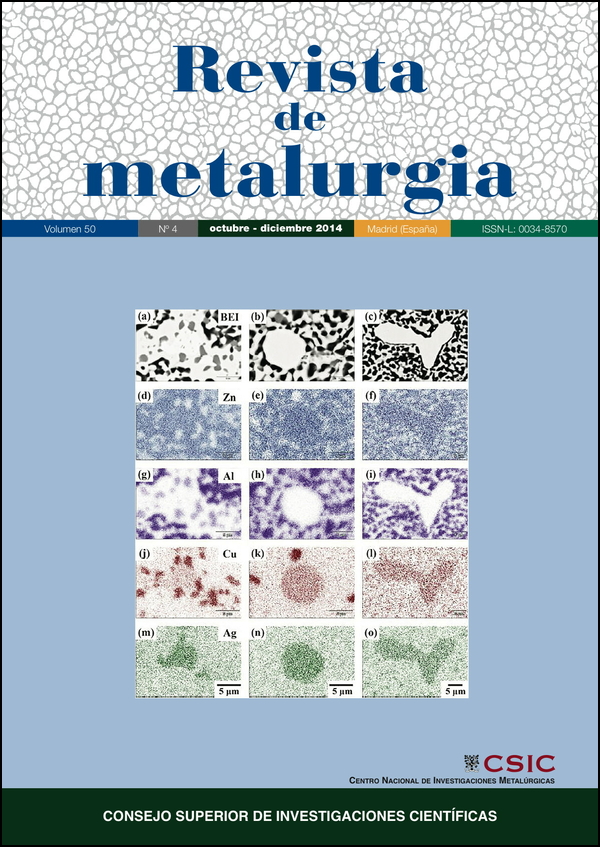Basic research on mechanism of BN inclusion in improving the machinability of steel
DOI:
https://doi.org/10.3989/revmetalm.028Keywords:
Boron Nitride (BN), Cutting mechanism, Free cutting steel, Inclusion, MachinabilityAbstract
Boron nitride-added eco-friendly free cutting steel has recently drawn more and more attention. But, the mechanisms explaining the role of BN inclusions improving the machinability of steels is not very clear. In this investigation, the material removal mechanism for cutting of BN inclusions in steels is explored, using a combination of theoretical analysis and a series of experiments. First, the actual shape of BN inclusions is observed and the amount and distribution of BN inclusions is quantitatively analyzed. Subsequently, the cutting performance of the steel is determined by cutting experimental tests. Moreover, the micro mechanical properties and the material removal mechanisms for cutting of BN inclusions are investigated by means of nanoindentation. The results revealed that the BN inclusions are hexagonal and are uniformly distributed, their average content is 23.2 per unit area and their volume fraction is 0.51% in the steel with 74 ppm B and 180 ppm N. It is shown that BN inclusions can improve the cutting performance of steel significantly, and a model describing the material removal mechanism for cutting of BN inclusions is proposed. BN inclusions act as stress concentration source, lubrication and wrappage of hard particles.
Downloads
References
Bao, Y.P., Wang, M., Jiang, W. (2012). A method for observing the three-dimensional morphologies of inclusions in steel. Int. J. Miner. Metall. Mater. 19 (9), 111–115. http://dx.doi.org/10.1007/s12613-012-0524-3
Chen, M., Liu, G., Zhang, X.H., Shen, Z., Yang, G.J. (2007). Experiment on machinability of new developed low carbon sulphur free-cutting steel. Chin. J. Mech. Eng. 43 (9), 161–166. http://dx.doi.org/10.3901/JME.2007.09.161
Emura, S., Yamamoto, S., Sakuraya, K., Tsuzakl, K. (2012). Free-cutting stainless-steel cast product and process for producing same, European Patent, EP 2537952.
Emura, S., Yamamoto, S., Sakuraya, K., Tsuzakl, K. (2013). Free-cutting stainless-steel material for precision processing and process for producing same. European Patent, EP 2565286.
Katayama, S., Imai, T., Onodera, N., Ishibashi, Y. (1988). Continuous-cast low-carbon resulfurized free-cutting steel, Patent US4719079, USA.
Liu, H.T., Chen, W.Q. (2014). Hot ductility of eco-friendly low carbon resulphurised free cutting steel with bismuth. Ironmak. Steelmak. 41 (1), 19–25. http://dx.doi.org/10.1179/1743281212Y.0000000095
Reich, S., Ferrari, A.C., Arenal, R., Loiseau, A., Bello, I., Robertson, J. (2005). Resonant Raman scattering in cubic and hexagonal boron nitride. Phys. Rev. B. 71, 205201-1-205201-12. http://dx.doi.org/10.1103/PhysRevB.71.205201
Sakuraya, K., Okada, H., Abe, F. (2006). Influence of heat treatment on formation behavior of boron nitride inclusions in P122 heat resistant steel. ISIJ Int. 46 (11), 1712–1719. http://dx.doi.org/10.2355/isijinternational.46.1712
Spitzig, W.A. (1983). Effect of sulfides and sulfide morphology on anisotropy of tensile ductility and toughness of hotrolled C-Mn steels. Metall. Trans. A. 14 (2), 471–484. http://dx.doi.org/10.1007/BF02644224
Spitzig, W.A., Sober, R.J. (1981). Influence of sulfide inclusions and pearlite content on the mechanical properties of hotrolled carbon steels. Metall. Trans. A. 12 (2), 281–291. http://dx.doi.org/10.1007/BF02655201
Tanaka, R., Yamane, Y., Sekiya, K., Narutaki, N., Shiraga, T. (2007). Machinability of BN free-machining steel in turning. Int. J. Mach. Tool. Manuf. 47 (12–13), 1971–1977. http://dx.doi.org/10.1016/j.ijmachtools.2007.02.003
Tanaka, R., Lin, Y., Hosokawa, A., Ueda, T., Yamada, K. (2009). Influence of additional electrical current on machinability of BN free-machining steel in turning. J. Adv. Mech. Des. Syst. Manuf. 3 (2), 171–178. http://dx.doi.org/10.1299/jamdsm.3.171
Wang, Y.N., Bao, Y.P., Wang, M., Zhang, L.C. (2013a). Precipitation behavior of BN type inclusions in 42CrMo steel. Int. J. Miner. Metall. Mater. 20 (1), 28–36. http://dx.doi.org/10.1007/s12613-013-0689-4
Wang, Y.N., Bao, Y.P., Wang, M., Zhang, L.C., Chen, Y.N. (2013b). Basic research on precipitation and control of BN inclusions in steel. Metall. Mater. Trans. B. 44 (5), 1144–1154. http://dx.doi.org/10.1007/s11663-013-9881-1
Wang, Y.N., Bao, Y., Wang, P.M., Zhang, L.C. (2013c). Precipitation and control of BN inclusions in 42CrMo steel and their effect on machinability. Int. J. Miner. Metall. Mater. 20 (9), 842–849. http://dx.doi.org/10.1007/s12613-013-0805-5
Yamamoto, K., Yamamura, H., Suwa, Y. (2011). Behavior of non-metallic inclusions in steel during hot deformation and the effects of deformed inclusions on local ductility. ISIJ Int. 51 (12), 1987–1994. http://dx.doi.org/10.2355/isijinternational.51.1987
Yoshimura, T. (1985). Method of Manufacturing Leaded Free-Cutting Steel by Continuous Casting Process, Patent US4524819. USA.
Published
How to Cite
Issue
Section
License
Copyright (c) 2014 Consejo Superior de Investigaciones Científicas (CSIC)

This work is licensed under a Creative Commons Attribution 4.0 International License.
© CSIC. Manuscripts published in both the printed and online versions of this Journal are the property of Consejo Superior de Investigaciones Científicas, and quoting this source is a requirement for any partial or full reproduction.All contents of this electronic edition, except where otherwise noted, are distributed under a “Creative Commons Attribution 4.0 International” (CC BY 4.0) License. You may read here the basic information and the legal text of the license. The indication of the CC BY 4.0 License must be expressly stated in this way when necessary.
Self-archiving in repositories, personal webpages or similar, of any version other than the published by the Editor, is not allowed.
















